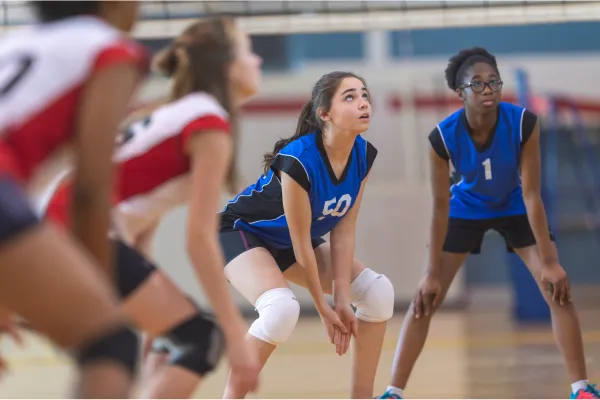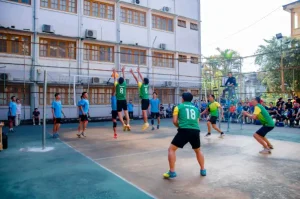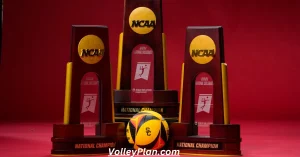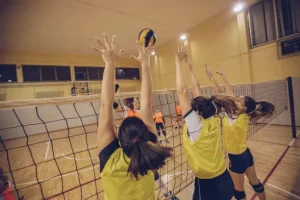Volleyball drills for serving are structured exercises designed to improve a player’s serving technique. A player should have to hit the ball with his hand and throw over the net to land inside the lines of the court.
A serve that is executed skillfully puts pressure on an opponent and leads to an advantage for your team.
In this article, we’ll study Importance of strong serve, fundamentals of serving, various serving drills and techniques that help you become a more skillful server.

Importance of a Strong Serve
A strong serve is a valuable asset in volleyball for several reasons:
| Importance | Description |
|---|---|
| Pressure on the Opponent | A powerful serve can force the receiving team into an uncomfortable position, making it harder for them to set up an attack. |
| Scoring Opportunity | An ace, a serve that lands in the opponent’s court untouched, can result in an immediate point for your team. |
| Setting the Tone | A well-placed serve can dictate the game’s flow, putting your team in control. |
| Disrupting Passing and Setting | A tough serve can disrupt the opponent’s passing and setting, making it more challenging for them to execute an effective attack. |
| Confidence Booster | A strong serve can boost your confidence and the morale of your team, setting a positive tone for the match. |

Serving Fundamentals
Before diving into specific volleyball drills for serving, let’s cover the fundamental principles of adequate serving:
Stance And Footwork
- Stand with your feet shoulder-width apart.
- Position your non-dominant foot slightly forward.
- Bend your knees slightly and maintain a balanced viewpoint.
Grip And Ball Placement
- Using your non-dominant hand, grasp the ball.
- Keeping the ball flat on your open palm, place it in your serving hand.
- To control the trajectory of the ball, use your fingertips.
Tossing The Ball
- Toss the ball slightly in front of you and to your serving side.
- The toss should be consistent and at a height that allows you to make contact at your ideal point.
Contact And Follow-Through
- Make contact with the ball using the heel of your serving hand.
- Follow through by extending your serving arm in the direction of your target.
- Aim for a clean, flat contact with the center of the ball.
Spin And Speed
- Add topspin to your serve by striking the bottom half of the ball.
- Generate power by transferring weight from your back to your front foot as you serve.

Beginner Serving Drills
For beginners, it’s essential to start with volleyball drills for serving that focus on the basic principles of serving.
Drill 1: Target Practice
Objective: To practice serving accuracy by targeting specific areas of the court.
Instructions:
- By using cones or markers, set up targets on the court.
- It would be best if you had to stand at the serving line and then serve the ball and aim to hit the targets.
- To start, practice with a large-size target and then reduce the size of the target to enhance your performance.
Drill 2: Controlled Toss and Serve
Objective: To work on consistent ball toss and serve placement.
Instructions:
- Begin by tossing the ball lightly to yourself, ensuring a controlled and consistent toss.
- Serve the ball to clear the net and land it in the opposite court.
- Focus on clean and accurate services without excessive power.
Drill 3: Serve and Move
Objective: To practice serving and quickly transitioning to the court.
Instructions:
- Stand at the serving line.
- Serve the ball over the net and immediately move to a designated spot on the court.
- Practice hitting serves and quickly adjusting your position for the next play.

Intermediate Serving Drills
Intermediate players can focus on refining their serving technique and adding more complexity to their training.
Drill 4: Serving to Zones
Objective: To develop the ability to serve specific zones on the court.
Instructions:
- Divide the court into zones or areas.
- Serve the ball to designated zones, working on placement and accuracy.
- Experiment with different serves, such as short serves, deep serves, and corner serves.
Drill 5: Serve and Pass
Objective: To practice serving and immediately transitioning to receive the pass.
Instructions:
- Stand at the serving line.
- Serve the ball over the net and quickly move to a position to receive the pass.
- Focus on serving and then passing effectively.
Drill 6: Float Serve
Objective: To learn the float serve technique, which involves minimal spin on the ball.
Instructions:
- Practice serving with a minimal spin, causing the ball to float unpredictably.
- Work on controlling the direction and placement of the float serve.
- Challenge the receiving team with the ball’s erratic movement.
Advanced Serving Drills
Advanced players can further challenge themselves with these volleyball drills for serving that replicate real-game scenarios.
Drill 7: Ace Challenges
Objective: To improve your ability to score aces (untouched serves) in real-game situations.
Instructions:
- Create a game-like scenario with a receiving team on the other side of the net.
- Serve to score aces and focus on placement and speed.
- Keep track of the number of authorities you achieve.
Drill 8: Zone Serving Under Pressure
Objective: To serve accurately to specific zones under pressure.
Instructions:
- Practice serving to designated zones while a coach or partner provides distraction and pressure.
- The coach or partner can simulate game situations, trying to distract or challenge your focus.
Drill 9: Target Serving with Variability
Objective: To serve accurately to designated targets with varied conditions.
Instructions:
- Set up multiple targets on the court.
- Serve to the targets while dealing with varying distances, heights, and angles.

Tips for Improving Your Serve
Regardless of your skill level, here are some general tips to enhance your serving technique:
| Tips | Description |
|---|---|
| Consistent Toss | Focus on maintaining a consistent and accurate ball toss for every serve. |
| Relaxation | Avoid tensing up. A relaxed body and arm will allow for better control and flexibility in your serve. |
| Mental Focus | Stay mentally engaged during serves. Visualize your target and execute with confidence. |
| Variability | Practice different types of serves, including topspin serves, jump serves, and float serves, to keep your opponents guessing. |
| Video Analysis | Record your serves and review them to identify areas for improvement. |
| Strength and Conditioning | Work on your strength and conditioning to generate more power in your serves. |
| Serve Under Pressure | Practice serving under simulated game conditions to prepare for real match situations. |

Common Serving Mistakes to Avoid
Serving can be challenging, and even experienced players make mistakes. Here are common errors to avoid:
| Common Serving Mistakes To Avoid | Description |
|---|---|
| Missed Toss | Inconsistent or inaccurate ball toss can lead to serving errors. |
| Hitting the Net | Serving into the net is a common mistake. Ensure your trajectory clears the trap. |
| Out-of-Bounds | Serving the ball out of bounds results in a point for the opposing team. |
| Lack of Spin | A serve with no spin is predictable and more straightforward. |
| Overexertion | Trying to serve too hard can lead to errors. Focus on control and placement. |
| Not Making Consistent Touch | Serving mistakes can happen when you don’t make consistent touch with the ball. |
Serving as a Strategic Weapon
A strong serve can be a strategic weapon in volleyball. Additionally, it can disrupt the opponent’s passing and setting, forcing them into uncomfortable positions. Now, discuss some strategic aspects of serving:
| Strategic Aspects Of Serving | Description |
|---|---|
| Targeted Zones | Vary your serves to specific zones on the court to challenge the receiving team’s positioning. |
| Zone Overloading | Serve multiple balls to the same zone to put extra pressure on the passer and setter. |
| Change of Pace | Mix powerful and softer, well-placed serves to keep the opponent guessing. |
| Late Breaks | Use last-second adjustments in your serve to catch the receiving team off guard. |
| Communication | Coordinate with your team to target specific opponents or areas of the court. |
FAQs
Serving initiates a point, game, or offense. Furthermore, a well-placed, difficult-to-pass serve directed towards a weak passer, setter, or rapid attacker, or exploiting a weak formation significantly disadvantages the opponent.
Choose a wall spot that is 8 to 9 feet high and serve from 10 feet away. Have them take a long step back and do it again after 10 good serves to the spot.
You must have your arms out early, and follow the ball into your arms, or it will move left and right, like a baseball knuckleball, sometimes dropping out. Additionally, the float serve is perhaps the most dangerous and difficult to pass.
Front-row outside hitter plays position 4 (left front). Setters usually set left front if the play breaks down. This is the tallest, farthest set, giving your team the most time to recover from a bad contact, adjust, and attack.
A volleyball player scores a kill by sending the ball over the net so the other team cannot return it. The team that executed the play scores when the ball hits the floor on the opponent’s side after powerful and well-placed strikes. Kills demonstrate a player’s offensive skills and help a team win.
Conclusion and Next Steps
Improving your volleyball drills for serving is an ongoing process that requires dedication and practice. Start with the fundamental principles, progress through appropriate drills. Additionally, always seek opportunities for improvement.
A strong serve not only contributes to your team’s success but also builds your confidence and presence on the court, whether you are a beginner or an advanced player.
Your commitment to enhancing your serving skills will undoubtedly lead to victories and personal growth in the sport.
Keep challenging yourself, meanwhile, learning from experienced players and coaches, and, most importantly, enjoy the process of becoming a formidable server on the volleyball court.
Your serves can make a significant difference in the outcome of matches; thus, your team will appreciate your effort in mastering this essential skill.
Related Posts
Why Do Volleyball Players Tape Their Fingers
What does SP(Sets Played) mean in volleyball
What is double hit in volleyball

Hassan Baig a former volleyball player, coach and Administrative At Volleyplan.com.
My name is Hassan Baig and I am a former volleyball player and coach. I have a passion for the sport and have dedicated my life to promoting it. I have worked with some of the best players in the game and have helped them achieve their full potential Read More









